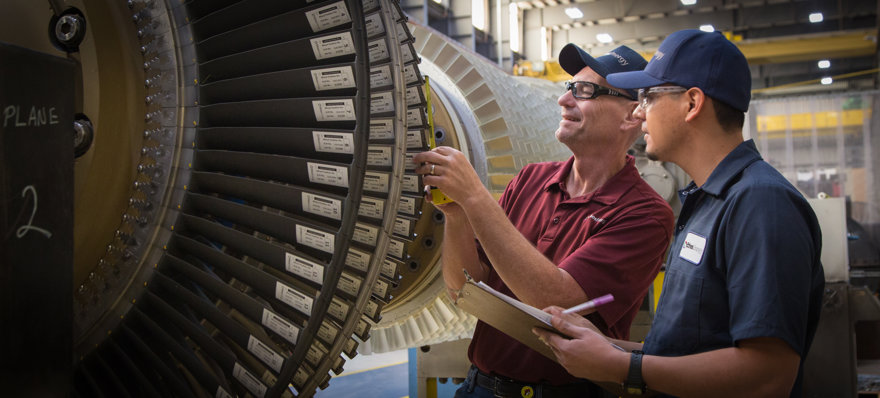Understanding gas turbine maintenance intervals: When to inspect and why
- Date
- August 18, 2025
- Category
- Impact

How to plan gas turbine inspections effectively
Gas turbines are the backbone of many power generation and industrial operations.
They do everything from driving efficiency to ensuring reliability.
Essentially, they keep everything running – until they don’t.
That’s why gas turbine maintenance is essential.
But the challenge lies in knowing exactly when to inspect your turbines – and why that timing seriously matters.
The first thing to remember is that turbines don’t follow a one-size-fits-all solution.
Different models, different operating hours, different levels of wear and tear – all of these things factor into when you should schedule your maintenance.
And if you’re following the GE’s GER 3620 bulletin, you’ll already know that maintenance intervals are prescribed based on factored fired hours or factored fired starts.
So here are the big questions:
Should you inspect early to reduce risk? Or should you push your maintenance to save on costs?
In this guide, we’ll break down everything you need to know about gas turbine maintenance schedules, why timing is so important, and how EthosEnergy’s experts can help you maximize efficiency while keeping downtime to a minimum.
The fundamentals of gas turbine maintenance
Gas turbines are specifically built to handle extreme conditions.
Whether they’re running continuously or operating in start-stop cycles, they undergo everything from high temperatures to intense pressures, all of which take thier toll.
However, even the most sturdy machines have their limits, especially when exposed to these conditions over a long period of time.
Heat, stress, and wear take their toll, making regular routine maintenance the key to reliability, efficiency, and long-term performance.
What determines maintenance intervals?
Turbine maintenance follows a strict schedule based on specific operating conditions.
There are two key factors that you can use to determine when inspections on your gas turbines are needed:
- Factored first starts (FFS): The number of times your turbine has been started and stopped, adjusted for the operational stress of each start.
- Factored Fired Hours (FFH): The number of hours your turbine has been in operation, adjusted for factors like load, firing temperature, and ambient conditions that affect how hard the unit has been working.
The three key inspections
Gas turbine maintenance typically will follow a cycle of three main inspections – with each stage building on the one before it.
In most modern maintenance strategies, Combustion inspections (CIs) are no longer performed as standalone events.
Instead, they’re incorporated into broader inspections like Hot Gas Path Inspections (HGPIs) and Major Inspections (MIs) to minimize downtime and optimize scheduling.
Here’s how that might look:
- Combustion Inspection (CI)
This focuses on the combustion system, including things like fuel nozzles, liners, crossfire tubes, and transition pieces.
Undergoing a CI is a necessary step to help you prevent early-stage wear and detect minor issues before they become bigger problems.
- Hot Gas Path Inspection (HGPI)
This examines key components like turbine blades, nozzles, and shrouds for wear and tear.
An HGPI helps you to maintain the efficiency and output of your turbines by addressing the parts that are exposed to the most extreme temperatures – which are often the parts that are most at risk. - Major inspection
This is the most in-depth overhaul you can do for your gas turbines.It will typically require a complete disassembly and inspection of your turbine’s compressor and rotor components to make the process as thorough as possible.
A major inspection will determine whether key actions like rotor replacement, life extension, or refurbishment are needed.
Understanding GER 3620 maintenance intervals
If you regularly work with gas turbines, you’ve most likely heard of GE’s GER 3620 – official guidelines for maintenance intervals.
It’s the industry standard for determining when inspections should happen on GE equipment, including turbine model, fired hours, and starts. But while GER 3620 gives a solid foundation, real-world operations aren’t always as predictable.
The benefits of early vs. late inspections
One of the biggest decisions operators face is whether to inspect early or push maintenance later down the line.
Each approach has its unique advantages and disadvantages:

Optimizing maintenance for maximum performance
Skipping or delaying gas turbine inspections might save you money in the short term, but it only increases the risk of costly failures such as turbine blade cracks, inefficient combustion, or – in worst-case scenarios – catastrophic rotor damage.
It’s about making smart decisions that maximize performance and minimize risk. By understanding GER 3620 intervals, factored fired starts, and condition-based maintenance, you can optimize your schedules and extend your turbine life.
Need a tailored maintenance plan?
Contact EthosEnergy today to discuss how we can help you turn potential into performance – while keeping downtime to a minimum.
